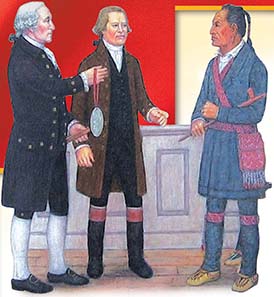SECTION 2: The Struggle Over Foreign Policy


▲ Washington presents Red Jacket with a peace medal (above right) at the 1792 meeting.
WITNESS HISTORY  AUDIO
AUDIO
A Great Orator Speaks
In 1792, government officials met with Native Americans in Philadelphia to discuss treaty issues and continuing skirmishes between settlers and Indians in the Northwest. In response to a plea from President Washington for peace, a famous Seneca orator replied,
“When you Americans and the king made peace [in 1783], he did not mention us, and showed us no compassion, notwithstanding all he said to us, and all we had suffered … he never asked us for a delegation to attend our interests. Had he done this, a settlement of peace among all the western nations might have been effected….”
—Red Jacket, 1792
Objectives
- Explain how territorial expansion brought Americans into conflict with the British and with Native Americans.
- Describe American relations with Britain, France, and Spain.
- Analyze how the political parties’ debates over foreign policy further divided them.
Terms and People
- Little Turtle
- Battle of Fallen Timbers
- French Revolution
- John Jay
- XYZ Affair
- Alien and Sedition Acts
- Virginia and Kentucky resolutions
- Aaron Burr
NoteTaking
Reading Skill: Identify Supporting Details Record details about early U.S. foreign policies in a chart like this one.

Why It Matters In addition to building a government, making peace with Native Americans, and maintaining control over expanded borders, the young United States had to establish itself in the international community during a volatile time. By 1793, Britain and France had resumed war, and both threatened efforts by the United States to stay neutral. Debate over America’s response to a war and to a revolution in France affected the nation’s foreign policy as well as its domestic structure. Section Focus Question: How did foreign policy challenges affect political debate and shape American government?
Conflict in the Ohio Valley
Although the United States had gained a vast new territory west of the Appalachians from the Treaty of Paris, the British kept their forts on the American side of the Great Lakes. Hoping to limit American settlement in the Northwest Territory, the British provided arms and ammunition to the Miami Indians and their allies, who were actively resisting American expansion into their lands. In 1790, Native Americans led by the war chief Little Turtle defeated a small force sent by President Washington to stop attacks against settlers. In 1791 in the Ohio Valley, British guns helped a confederacy of many Indian nations, again led by Little Turtle, to crush a larger American force commanded by General Arthur St. Clair.
But the tide turned in August 1794 when federal troops led by General Anthony Wayne defeated the Native American confederacy at the Battle of Fallen Timbers, named for the fallen trees that




